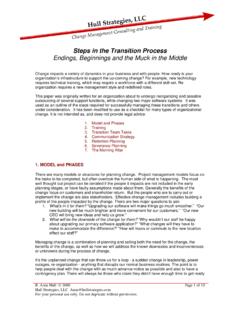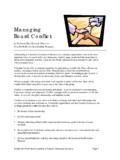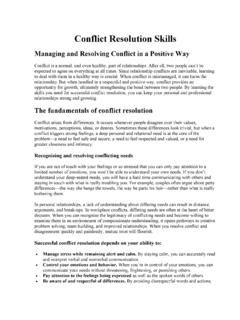Transcription of Behavior Management Models - SAGE Publications …
1 21 Behavior Management ModelsChapter ObjectivesAfter studying this chapter, you should be able to describe what is meant by discipline, explain how assertive discipline is implemented, define logical consequences, illustrate how to implement the reality therapy model, specify the approach of love and logic, describe the Ginott model, characterize the Kounin model, depict the Jones model, explain what character education is, and describe two character education programs, characterize the pros and cons of each of these Models , list the five concrete recommendations to help teachers reduce common Behavior problems, define the behavioral model and its characteristics, describe the misunderstandings of the behavioral model, and specify the right to effective behavioral treatment and the right to an effective 1 Behavior Management Models 3 OverviewThe topic of how to manage student Behavior ( , a clearly defined and observable act) in schools has been around as long as there have been schools.
2 Behavior man-agement has been and still is the chief concern of educa tors across the country (Dunlap, Iovannone, Wilson, Kincaid, & Strain, 2010; Westling, 2010). When stu-dents misbehave, they learn less and keep their peers from learning. Classroom Behavior problems take up teachers time and disrupt the classroom and school. In fact, difficulty managing student Behavior is cited as a factor associated with teacher burnout and dissatisfaction. For example, 50 percent of urban teachers leave the profession within the first five years of their career, citing Behavior problems and Management as factors influencing their decision to leave (McKinney, Campbell-Whately, & Kea, 2005, p. 16). More should be done to create effective classroom environments through the use of better classroom Management approaches (McKinney et al.)
3 , 2005; Westling, 2010). Every year, new and improved Behavior Management approaches hit the schools only to be thrown out by the end of the year. There are at least five possible causes for this cycle. First, preservice teachers may not be trained well in Behavior Management methods. Typi cally, a single classroom Management class that provides a superficial view of Behavior Management is offered. Second, teachers may not be trained to ana-lyze research on behav ior Management approaches. We tend to flock to the flavor of Controlling Angry Outbursts Through Evidence-Based PracticesMS. JACKSON HAS A STUDENT in her seventh-grade classroom who is having difficulty due to his angry outbursts. Ms. Jackson has tried a variety of techniques to decrease Jos s outbursts, all without success.
4 She has tried telling him how his actions affect others. She has also tried to help him manage his anger by counting to 10 before he speaks. As a last resort, Ms. Jackson has been sending Jos to the office, where he talks about his anger with a school Jackson does not know what to do. She has discussed the problem with other teachers and has tried their suggestions. She has asked Jos s parents to help her by talking with Jos and by not allowing him to play video games after school if he has a difficult Jackson recently learned Jos had been assessed two years previously for a suspected Behavior disorder. The assessment team, however, determined he did not meet the criteria for such a disability. She has also learned Jos has had counseling services over the last few years but to no avail.
5 Most teachers believe Jos is simply a student who has difficulty controlling his anger and that the best way to prevent his angry outbursts is to stay away from him and not to make any demands when he is in a bad Jackson, however, believes that not making demands on Jos to prevent outbursts is not a viable option. She believes doing so is not really helping her or Jos . She also believes her job is to teach Jos how to act appropriately while he is in her classroom. Therefore, Ms. Jackson decides to journey into the world of Behavior Management approaches to see what has been found to work in situations such as Part I IntroductIon to Behavior ManageMentthe month procedures without a great deal of regard for what has been shown to work. Third, there is no unified theory of Behavior Management .
6 Because the causes of Behavior problems are often not agreed on, teachers may become confused about the causes of student Behavior . Fourth, schools often do not have a seamless and consistent approach to Behavior Management utilized across classrooms, teachers, and grade levels. Teachers tend to implement their own procedures causing confusion on the part of students. Finally, Behavior Management is often viewed as a reactive approach to Behavior problems rather than as a proactive believe Behavior Management planning must occur at three levels. Figure shows Behavior Management as three concentric circles. The smallest circle relates to the implementation of individualized Behavior Management supports for the most troubled students. Traditionally, Behavior Management training in special educa-tion has occurred at the individualized level.
7 The middle circle is handled from a classroom perspective and includes effective instructional supports. Behavioral and academic programming are key aspects in the prevention of and reaction to problem Behavior in the classroom. The largest circle represents schoolwide supports designed Figure Comprehensive Behavior Management PlanningIndividualizedSupportsClassroom SupportsSchoolwide SupportsChapter 1 Behavior Management Models 5to prevent and respond to Behavior difficulties at the school level. These concentric circles are dependent on one another and form a comprehensive approach to Behavior Management . This comprehensive approach is important given the recent shift by schools from a reactive approach to Behavior man-agement to a proactive one (Lane, Wehby, Robertson, & Rogers, 2007).
8 Viewing Behavior Management in this way is also helpful in reducing the staggering drop-out rates in the United States (Dynarski et al., 2008).This chapter describes what is meant by disci-pline and various Models used in schools to deal with student Behavior . An analysis of each of the Models is provided including their positive aspects and weak-nesses. Additionally, five concrete recommendations to help teachers reduce common Behavior problems are described along with a description of the behav-ioral model. Given that the conceptual focus of this textbook is behavioral, we discuss the misunder-standings of the behavioral model. Finally, behavioral ethics are highlighted via position statements from the Association for Behavior Analysis.
9 Essentially, these statements lay out the rights individuals have to effective behavioral treatments and to an effective education. If we use effective Management methods derived from the research lit-erature, we can make significant positive gains in the lives of teachers and students. What Is Discipline?Over the years, discipline has been equated with punishment, specifically, corporal punish ment. Punishment and discipline, however, are not the same thing. Discipline involves teaching others right from wrong. Specifically, discipline includes methods to prevent or respond to Behavior problems so they do not occur in the future (Slavin, 2009). The following are common definitions of the word dis cipline found in most dictionaries: training to act in accordance with rules, instruction, and exercise designed to train proper conduct or action; Behavior in accordance with rules of conduct; and a set or system of rules and regulations.
10 As seen in these definitions, discipline is about teaching students how to behave appropriately in different situations. It is not punishment, although punishment is one possible way of disciplining should discuss with students expected Behavior in the Part I IntroductIon to Behavior ManageMentWhat Are Some Popular Behavior Management Models Used in Schools?With the changing attitudes toward the use of punishment-based disciplinary proce-dures, schools have looked for alternative Models of student discipline. These Models were and are aimed at developing and maintaining appropriate student Behavior . The authors of these Models try to describe why they work. Unfortunately, many of them have overlooked some important fundamentals; that is, they ignore the ef fects on stu-dents and fail to use scientific, functionally based definitions in their Models .

















